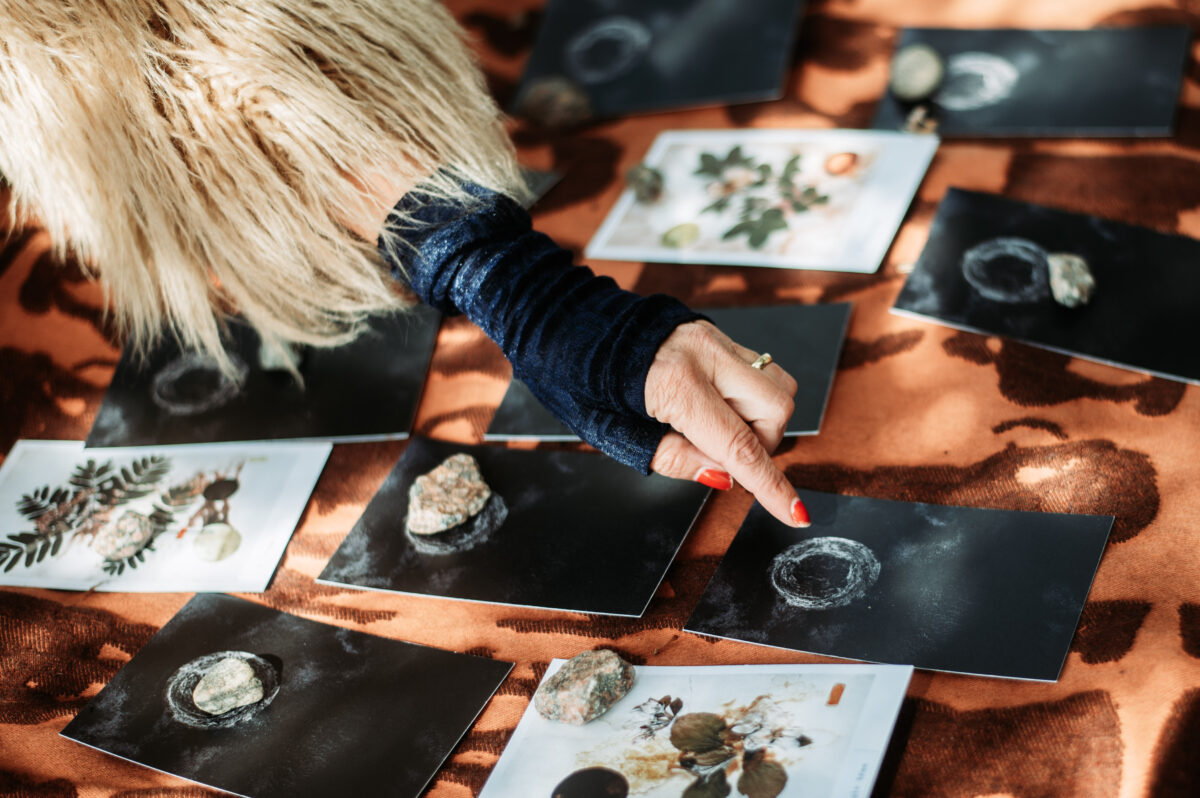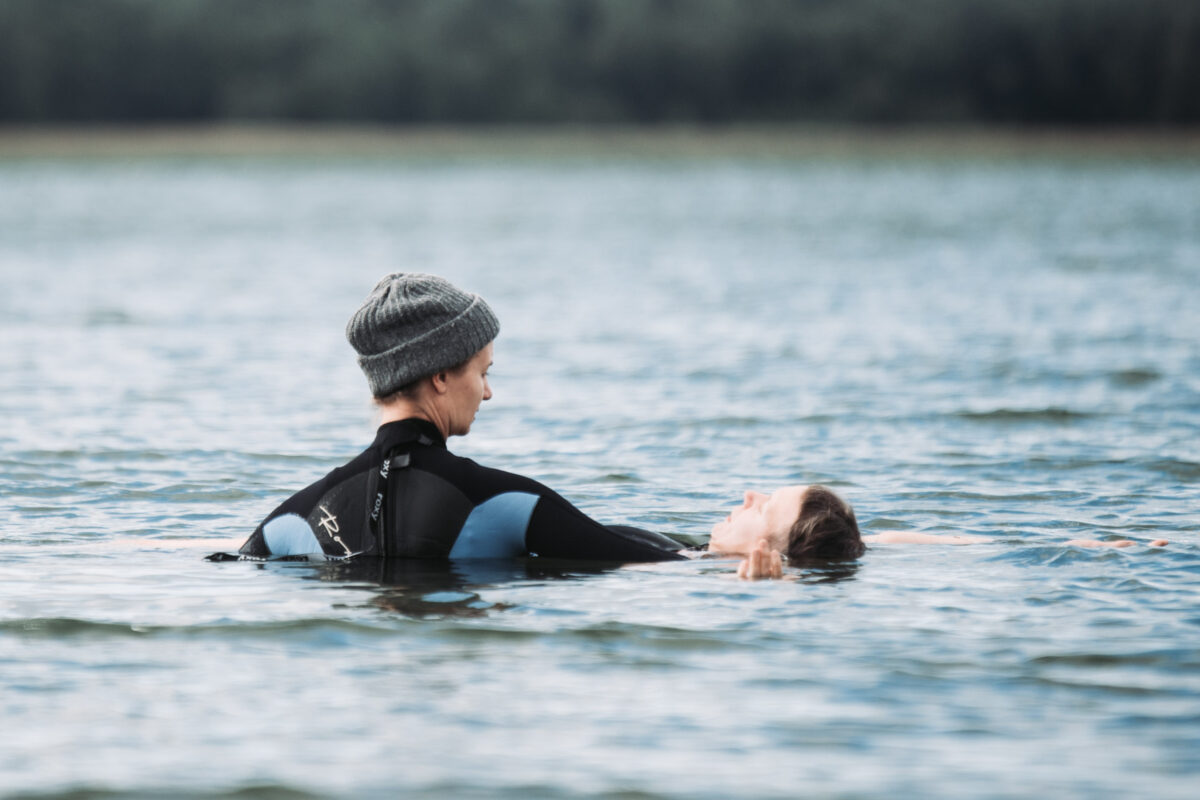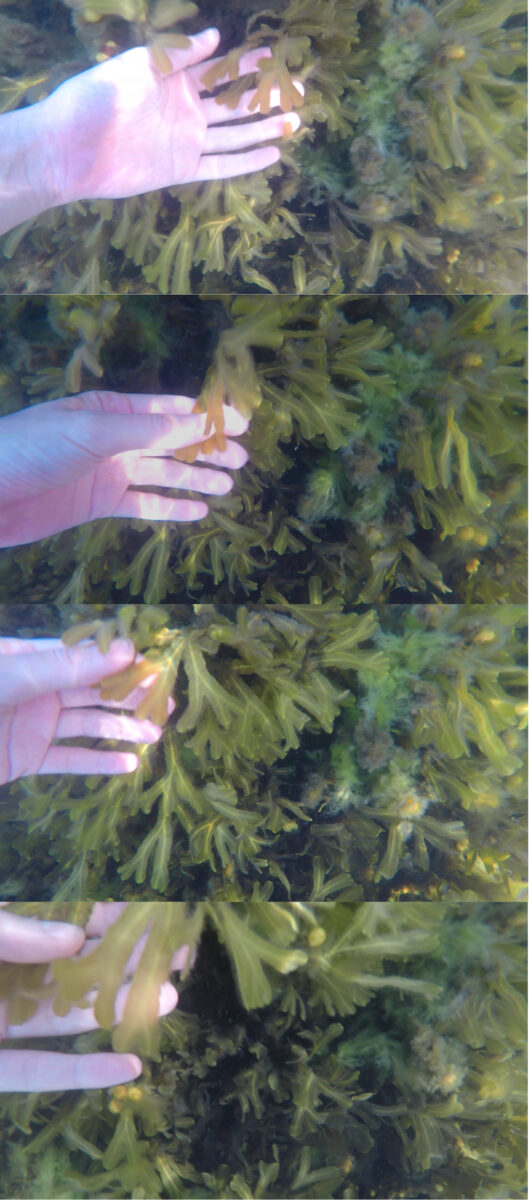Field notes: Exercises in Attentiveness II
CAA x NPT How do you know what you know? Exercises in Attentiveness II
Ruissalo Island, Kino Diana and Manilla, Turku
Saturday 3.9.2022
How do you know what you know? This question holds within it a rhizomatic crisscrossing of enquiries. How do you acquire and navigate knowledges? Whose knowledges are they? Where do they come from? Which knowledges do you embrace, support and uplift? How do you begin to reflect on what, and how, you know?
On Saturday 3rd September, CAA and New Performance Turku co-hosted a day-long public programme in the Turku area. CAA x NPT How do you know what you know? Exercises in Attentiveness II invited audiences to engage with notions of knowledge and attentiveness through immersive exercises on the island of Ruissalo and discursive activities at Kino Diana and Manilla Kulttuuritehdas in Turku. Taking place on the cusp of autumn – the freshness of the new season settling into the seams of our skins – the day moved with a reflective intent and provided a moment in which to consider the methods, protocols and rituals which have been inherited, borrowed, invented or emerging from dialogues between artists and scientists at the Archipelago Research Institute over the last four years.
Though staged at a geographical distance from Seili, the island remained at the forefront of our minds and movements throughout the day. Lotta Petronella gave plant-card readings in Själö Poiesis: Reading with Plants; Maija Mustonen and Ami Karvonen mediated the floating exercise Buoyant in the Archipelago Sea; Kati Roover led audiences into an archipelagic deep-time with her film The Scent of the Changing Sea; FRAUD (Audrey Samson and Francisco Gallardo) reflected on their long-term legal-ecologies project Fields of May; and Kalle Hamm performed excerpts from Band of Weeds’ forthcoming album, The New Pangaea, before DJ Antti-Juhani Manninen played some celebratory beats late into the evening.
Instead of seeking to answer its titular question, How do you know what you know? Exercises in Attentiveness proposed a multitude of tools to open up alternative, non-linear modes of knowledge-making and gathering. Each exercise and activity asked audiences to consider the knowledges that they hold, nurture and share, while encouraging an attentiveness towards alternative carriers of knowledge – plants, waters, bodies, mosses, timber. In participating in the sessions, new questions and reflections arose throughout the day and have continued to seep into this writer’s body throughout the last few months.
What does it mean to ‘know’ something? Is it possible to truly ‘know’ in worlds that are perpetually changing, with ecologies that move and beings that are fleeting? Does knowledge not change and flex as it collides or interweaves with other knowledges across multiple times, spaces, minds and bodies? What does the society that I live in value as ‘knowledge’, who or what are the ‘unsung’ carriers of ‘knowledge’, and which knowledges and carriers are hidden by hegemonic powers?
Ruissalo, 13h00
In Ruissalo, the exercises engage vividly with matters of both bodily and cognitive attentiveness. How do you learn to be attentive? How do you attend to the knowledges between, amongst and beyond louder narratives? Which senses do you use to fathom these knowledges?
The day begins with a grounding on the sandy shores of Saaronniemi. Lotta Petronella is giving private readings with plants from Seili under the curving branches of pine trees. In Själö Poiesis: Reading with Plants, cards are laid onto a blanket and gently turned face-up to disclose a narrative which holds Seili’s stories together with those of a participant. The tarot-esque cards, created in collaboration with artist Cecilia Westerberg, speak of the knowledges embedded in plants discarded as ‘ordinary’. The work leans into various types of knowledge-gathering – botany, storytelling, the occult, archival – to access and learn from the tales contained within and gestated by hidden carriers – plants, oils, rocks and women. Notes on Reading with Plants can be read here.
The beach is shared with Maija Mustonen who, along with her collaborator Ami Karvonen, pads up and down the shore from sauna to sea. The artist and performer is facilitating a floating exercise in the Archipelago Sea. Buoyant, a project devised by Mustonen together with Karvonen and Even Minn, leads participants into the water to experience the supportive capacities which arise at the interconnection between body and sea. The participant, the artist and waters converge to create a meditative experience in which the partaker has the opportunity to attend to the quieter murmurings of this world. The knowledges which are carried in skins, salts, neoprene and waters chatter as they enmesh with one another and we begin to listen more intently. Notes on Buoyant can be read here.
In each of these activities, my mind and body converse with other minds and bodies. I quieten my pace, settle, and listen to the stories gathering in my head, the lapping sea in my ears and the tingling of my skin. These exercises invite me to lean into the senses that my body is equipped with but that I have, at times, forgotten to engage with. Are senses a tool with which to unlock hidden knowledges or could they be carriers of knowledge in themselves, too?
Kino Diana, 16h00
I watch as epochs enfold into one another in Kati Roover’s The Scent of the Changing Sea. The screening in Kino Diana speaks to my senses of sight, hearing and, by imagination, smell, while challenging my cognitive notions of time, words and worlds. “Eemian Sea, Yoldia Sea, Ancylus Lake, Littorina Sea,” Roover moves through the Baltic Sea’s predecessors before calling into question what ‘name’ might be given to this next body of water – will it be a lake, a swamp or land? And what will become of its light, salty scent? Who, or what, will be here to smell it? Rocks? Mosses? They, as the artist reflects, remember and still speak of a time when the last glaciers melted.
In observing the scenes and sounds of waters gurgling between ices and bladderwrack, footsteps padding amongst spiralling labyrinths, and mosses gathering between the ages, I contemplate the loudness of our own languages (some more than others) and the necessity to listen better to the voices that sound around us. Roover does not include an audible human storyteller: the artist, instead, narrates this shared-tale with text displayed along the bottom of the screen. In the absence of a familiar spokesperson what we, the audience, experience is an alternative understanding of the words that we use and the voices that we choose not to listen to: here, it is the crashing waters and unfurling mosses that animate unspoken phrases in tongues of another kind.
I slip into a dreamlike trance as multiple seasons, scales and voices are layered into one another, and I begin to understand the need for cyclical thinking. In western society, we have conditioned ourselves into moving with a cool, clean linearity, where everything belongs to a specific time and place when, in actuality, agents are continuously conversing, back and forth, across different eras. “[T]his is a place where multiple lives meet” writes Roover, a sentiment that is vividly present in her layering of audio and visual material but also in her meshing together of shamanic, technological and scientific knowledges: together, we walk with the artist’s body and camera through a Jatulintarha labyrinth before plunging beneath the sea’s surface, first into lush algae, then into a dark, murky seabed. We are eased into microscopic views of plankton laced with scenes of lapping surface waters, and drawn into deluges of marine snow falling amidst a cargo ship on the horizon. Within this 14-minute film, the colliding knowledges of multiple times, bodies and worlds become visible.
Manilla, 19h00
The evening brings us towards matters of accountability. How might you become more accountable for the knowledges that you embrace, gestate and activate?
Manilla Kulttuuritehdas, our venue as dusk settles in, is a buff-coloured structure thick with its own stories and echoes. Its name ‘Manilla’ conjures up a number of associations: Manil(l)a paper, envelopes, hemp (or abacá) and rope – each of which, as either a trade good or raw material (historically or otherwise), is woven into the fabrics of societies, traditions and cultures. This building, a former rope factory-turned-cultural centre, is a carrier of knowledge in itself, and its narratives converge with FRAUD’s long-term project, Fields of May, in more ways than one.
Aside from being our locale of conversation, Manilla was once a rope supplier to ships like the Sigyn, a 19th-century wooden trade barque whose old masts have been repurposed by FRAUD. Which knowledges seep through into our conversations, here, in Manilla? Inside, the artistic duo share their journey from Midsummer Mast to Fields of May. A plant-based tincture prepared by Lotta Petronella is served. It is warm and earthy. As I listen and observe the slides in front of me, I consider the rituals that respire in this moment – tea-drinking, presenting, sharing, salvaging.
We are drawn into the stories of maypoles – their significance in Finnish maritime histories as well as their presence in former common law tribunals in England – by a sequence of archival materials layered amongst images of FRAUD’s activities in Seili and Turku. In speaking, the duo call into question our modern and contemporary notion of ‘tradition’ and propose that we might de-construct and re-claim certain traditional processes as active agents in future rituals. They describe their activities as collaborating across “different building models and practices” to “develop rituals for ecological survival”.
In Fields of May, the infrastructures of ship-building, trading and legal rights – and the hidden labour, lives and stories that go into them – are exposed and reconfigured into a form which supports alternative, non-extractive rituals like multi-species conversation. The Sigyn‘s ship-mast that was once a pillar for trade now lays horizontally outside the Archipelago Research Institute in Seili to chair discussions between ‘witnesses’ from different strata of the Baltic Sea. FRAUD challenges hegemonic knowledge by teasing apart its structures to reveal, and uplift, the metaphorical and material bodies which have either been quashed or forgotten beneath its heftiness.
It is visible in their deconstructing and reassembling of material histories that the artists search for what Arturo Escobar (2004) describes as the “languages and visions” which might be “appropriate to today’s problem- space of capitalist hegemony and counter-hegemonic struggles[..]”. They ask, as Escobar asks, “What might be the role, if any, of what used to be called ‘traditions’ in this regard?” Their use of salvaging is not to encourage a repeating of history, but rather to re-claim and re-envision traditional knowledges to better tackle the socio-ecological challenges that we face today.
The question of “whose responsibility is it to ensure the future biodiversity of the Archipelago Sea and, in-turn, the country and the rest of the planet?” arises in the conversational session with Professor Emeritus Ilppo Vuorinen, who points out that, according to the Constitution of Finland, it is the responsibility of every Finnish citizen to ensure the future biodiversity of the Archipelago Sea. FRAUD asks us to consider, then, “What is the role of the law? Is it to grant rights to nature or encourage care from people?” What would granting legal personhood to the Archipelago Sea, for example, bring as opposed to introducing and strengthening the laws of ecological care into our current value systems?
Towards the end of the evening, the question of gratitude arises. How do you show gratitude to that and those whom carry and provide alternative knowledges – and make our everyday possible? Who do we, and how do we, thank for these knowledges?
Kalle Hamm begins to play a sequence of soft, earthy sounds. This excerpt from The New Pangaea starts deep beneath the understory in soils threaded through with mycelium, or so I imagine. Gently, the vibrations trickle upwards from ground to air – from the curling of roots to the reaching of leaves – becoming near-weightless in their resonances before transitioning into a singular voice and then into a collective choir. At first, I consider how the composition meanders between the voices of plants and those of humans (a series of ethereal notes are sung by vocalist Anniina Saksa), only to reflect that the sounds I hear are continuously entwining. Neither plant nor human are exclusive but, instead, combine and converge.
In a conversation following the performance, Hamm elaborates upon the work’s collaborative realities by acknowledging that the sounds we hear are a sonification – a translation from signal to sound – of the electromagnetic waves produced by the movements of fluids and nutrients in plants. He also describes the multiple environmental and situational factors that affect the ‘sounds’ gathered from the plants on Seili: the time of day, the seasons, the minerals available. What we hear, thus, are plants and their habitats, but also the creative decisions made by the artists – e.g. the frequencies used to ‘listen’ to each plant – as well as the impact of human infrastructures like electrical lines and buildings on the field recordings gathered. Even human migration plays a role in this composition when taking into consideration that many of Seili’s plants were brought to the island by generations of human activity.
This closing piece for Exercises in Attentiveness II is an opening for listeners to engage with intertwining rhythms. Part-human, part-plant, part-technology, the voices heard belong to neither one but rather a mutualism of many. It is perhaps not about ‘giving voice’ to another (as an audience member asks the valid question of, “how do we give voice and/or recognise the voice of another?”) but rather about vocalising the crisscrossing rhythms that reverberate amongst multiple agents. Perhaps this is how we pay gratitude; by listening to and moving with the rhythms that connect they, you, we and I together.
Field notes by Selina Oakes.
NPT x CAA How do you know what you know? Exercises in Attentiveness I and II are organised in collaboration with New Performance Turku and form part of a wider series of events collated under the same title. The programme and the presented art works are produced as part of CAA’s project Spectres in Change in collaboration with the Archipelago Research Institute, and have been supported by Kone Foundation, the Swedish Cultural Foundation in Finland and the Oskar Öflund Foundation.




















